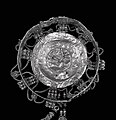File:Hairnet - Getty Museum (92.AM.8.1).jpg

Original file (1,546 × 3,057 pixels, file size: 592 KB, MIME type: image/jpeg)
This is a file from the Wikimedia Commons. Information from its description page there is shown below.
Commons is a freely licensed media file repository. You can help.
Summary
Object
| Ptolemaic hairnet
|
|||||||||||||||||||||||||||
|---|---|---|---|---|---|---|---|---|---|---|---|---|---|---|---|---|---|---|---|---|---|---|---|---|---|---|---|
| Artist | |||||||||||||||||||||||||||
| Title | |||||||||||||||||||||||||||
| Part of |
Collection of Ptolemaic jewelry |
||||||||||||||||||||||||||
| Object type |
hairnet |
||||||||||||||||||||||||||
| Description |
|
||||||||||||||||||||||||||
| Depicted people | |||||||||||||||||||||||||||
| Date |
between 225 and 175 BC date QS:P,-0500-00-00T00:00:00Z/6,P1319,-0225-00-00T00:00:00Z/9,P1326,-0175-00-00T00:00:00Z/9 |
||||||||||||||||||||||||||
| Medium |
gold, gemstone and glass paste |
||||||||||||||||||||||||||
| Dimensions |
height: 21.6 cm (8.5 in) dimensions QS:P2048,+21.6U174728 dimensions QS:P2049,+7.9U174728 dimensions QS:P5524,+7.6U174728 |
||||||||||||||||||||||||||
| Collection |
institution QS:P195,Q180401 |
||||||||||||||||||||||||||
| Current location | |||||||||||||||||||||||||||
| Accession number |
92.AM.8.1 (J. Paul Getty Museum) |
||||||||||||||||||||||||||
| Place of creation |
Ptolemaic Kingdom |
||||||||||||||||||||||||||
| References | |||||||||||||||||||||||||||
Photograph
| DescriptionHairnet - Getty Museum (92.AM.8.1).jpg | ||||
| Source |
The Getty Center, Object 103Z0E
|
|||
| Author | J. Paul Getty Museum | |||
| Permission (Reusing this file) |
|
|||
| Other versions |
|
Captions
Items portrayed in this file
depicts
image/jpeg
File history
Click on a date/time to view the file as it appeared at that time.
| Date/Time | Thumbnail | Dimensions | User | Comment | |
|---|---|---|---|---|---|
| current | 03:46, 15 March 2024 |  | 1,546 × 3,057 (592 KB) | DEGA MD | Uploaded a work by The J. Paul Getty Museum from getty.edu with UploadWizard |
File usage
The following 2 pages use this file:
Metadata
This file contains additional information, probably added from the digital camera or scanner used to create or digitize it.
If the file has been modified from its original state, some details may not fully reflect the modified file.
| Author | The J. Paul Getty Museum |
|---|---|
| Image title |
|
| Short title |
|
| Credit/Provider | The J. Paul Getty Museum, Villa Collection, Malibu, California |
| Source | The J. Paul Getty Museum |
| Usage terms | |
| Online copyright statement | http://www.getty.edu/legal/copyright.html |
| JPEG file comment | Generated by IIPImage |
| Contact information | rights@getty.edu
www.getty.edu 1200 Getty Center Drive Los Angeles, California, 90049 United States |
| Date metadata was last modified | 23:23, 12 February 2020 |
| Copyright status | Copyright status not set |










